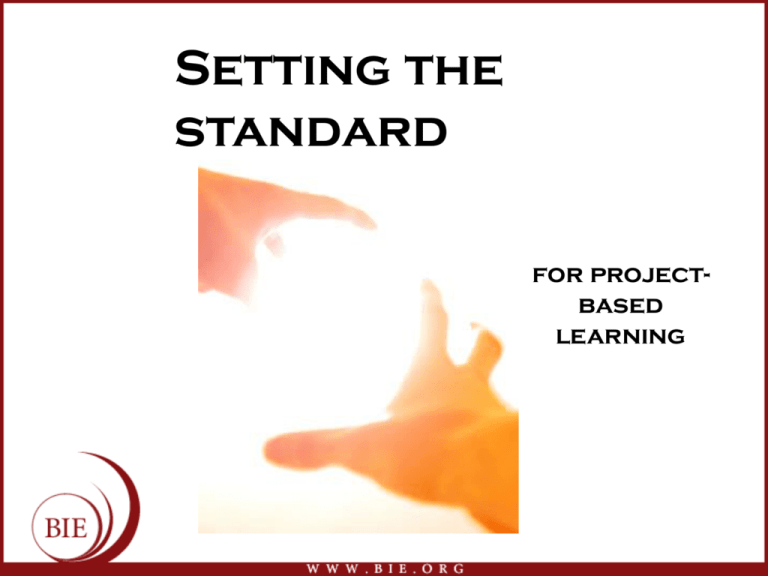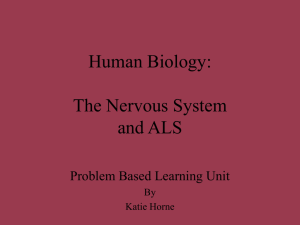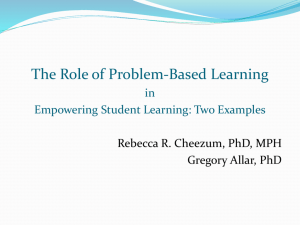Day ONE Design Power Point
advertisement

Setting the Title Here standard for projectbased learning Tony Harris http://misterharris.org (should be online this week) http://web.mac.com/misterth/misterharris/MRH_main.html -click on PBL .docs and suggested PBL reading The Buck Institute for Education is… • An educational research and development organization; focused on 21st-century secondary school reform through project based learning • A nonprofit 501c(3) funded in perpetuity by the Leonard and Beryl Buck Trust • Located in Novato, California (20 mi. north of San Francisco) Begin With the End in Mind -mapping backwards Your ideal grad – begin with the end in mind Title Here Your ideal grad – begin with the end in mind Title Here Your ideal grad – begin with the end in mind Title Here form Leadership skills -Habits of Mind -21st Century Skills -SCANS Skills -Essential Abilities Leadership skills available online - Communicate Effectively and Persuasively: - Manage Projects Effectively: - Think Critically: - Solve Problems Resourcefully: - Express Themselves Creatively: - Collaborate Productively: Measureable? Assessable? Make it happen By changing the context This requires Transformational Change in: -Environment -Instruction -Control (5th Grade, Rancho) Aviation High QuickTime™ and a Sorenson Video 3 decompressor are needed to see this picture. What did you see? Hear? Task: In your table groups, review your impressions of the classroom behaviors (of the teacher and students) you viewed. Discuss. Report Out Your group’s ideas/observations Bacterial Transformation Lab Vid….. (COT form) Observation redux Task: In your table groups, review the classroom observation tool. (form) -Divide observation duties -Observe the next video and record your data Report Out Your group’s ideas/observations when the video is over Role of the teacher Data flow Teacher talk Textbooks Output Teachers Role of the teacher Internet research Supplemental reading Data flow TV and film Expert Interviews Teacher talk Community Feedback Textbooks Student talk Teachers Real-world experience Output Parents Peers Community World Role of the teacher Learner Facilitator Builder Partner Model Expert Ask yourself: What has been the basis of your most satisfying interactions with kids? Role of the student Respect the professionalism of teachers Learn from failure Do the right thing when no one is looking Ask for help Seek more than a correct answer Inquire Ask yourself: Would these behaviors help produce your dream classroom? 6 traits of highly effective schools Challenging and cohesive learning environment Coherent instructional program Professional community of teachers Effective school leadership Emphasis on improvement Parent and community involvement Source - North Central Regional Educational Laboratory Pbl vs. projects (Tech High) Projects PBL Teacher directed Inquiry based Highly structured Open-ended Summative On-going Thematic Driving question/challenge Fun Engaging Answer giving Problem solving De-contextualized – School world Contextualized – Real world Continuum of Practice The Six A’s of Project Design -Authenticity -Academic Rigor -Applied Learning -Active Exploration -Adult Relationships -Authentic Assessments Simultaneous Outcomes (achieved through various benchmarks, or, the process itself) Content Academic Skills Leadership Skills Products Community involvement Standards Etc. Project #1 The Debate Students in the 9th grade Humanities Core (English and Social Science) are told that they will be doing a 2-week unit of study designed to build their oral language skills (use of persuasive arguments, evidence to support an opinion, rhetorical devices, etc.). They are divided up into teams to prepare for a debate on one of three topics: school uniforms, curfews, and homework. Each group does research and prepares arguments for both sides, since they will not know which position they will take until the day of the debate. Their performance in front of the class is scored with a rubric and their written notes and arguments for both sides are turned in for grading. Project #2 Evolution In a core program for high school freshmen, a team of three 9th grade teachers from Science, Social Studies, and English have decided that they will develop a one-month project on evolution. The project will address content standards for genetics and evolution, patterns of global change in an era of imperialism, and literary response and analysis. The team settles on the Driving Question: “Is Evolution a Positive Force for Change and Progress?” For curriculum, students in the science class will study Darwinism, natural selection, and Mendelian genetics. In Social Studies, students in a World Cultures class will examine theories of evolution and mythology in India. In English, students will read and discuss the novel Lord of the Flies. The products will be a fruit fly experiment in Science, a visual essay of Indian mythology in World Cultures, and a literary response paper in English. The three products will be posted on a digital portfolio of work collected by students over their four years, under the title “The Evolution Project.” parallel learning……. vs. ……..integrated curriculum QuickTime™ and a Sorenson Video 3 decompressor are needed to see this picture. What is PBL? In your groups, using your prior knowledge, experience, and information from today so far, create a poster that communicates the essential components of a successful PBL classroom. Begin With the End in Mind -mapping backwards What’s the point? Who’s involved? What are the main products? How is it all tied together and presented? Are there any standards in there (somewhere)? Ma and Pa Kettle (beliefs and deprogramming) Mis-belief system It’s not standards-based I can’t use traditional teaching tools It’s loud and messy No individual accountability I can’t cover all required material/standards (Power Standards Belief system Rigor Relevance Relationships Rigor Relevance is more than high test scores Evokes prior knowledge; demonstrates future application Relationships drive rigor (Eric) Project phases *1. Begin with the end in mind 5. Manage the process *2. Craft the Driving Question 4. Map the project 3. Plan the Assessment Entry Documents and Events!! (mythbuster’s) Creating a “need to know” Task: Act like a teenager (a well-behaved one) and respond to prompts from your instructor after reading the Entry Event for the project. (Puritan Memo) “If I Build It Packet” online The driving question – and more Provocative Open-ended Authentic Concrete Relevant and rigorous Requires core knowledge to answer Requires process skills (21st CS) to complete Design tip: A project can be shaped by a challenge statement, an investigation, a community issue or student interest What’s a DQ look like? What is a safety shed? How can we design and build a cost-effective, fireproof safety shed that can be used in all high schools in the district? What’s a DQ look like? What is a heart-healthy meal for seniors How do heart-healthy meals nurture seniors and extend longevity? What’s a DQ look like? How do we design an effective, low-cost water filter? How do we design an effective, low-cost water filter that prevents toxins from entering the Lake Washington? A good Driving Question evokes a deeper, richer, and more dense response. Your turn Working in table groups (no more than 3-5 per group), use the handout to select, refine or create a driving question. ( Archetypes DQ form) Report Out Your group’s ideas/observations The Refining protocol Question 1: Can my students read and comprehend the driving question? Question 2: Is the driving question open-ended or can it be answered with a “yes” or “no?” Question 3: Does the driving question allow me to create a local context for the topic(s) under study? Question 4: Does the driving question offer opportunities for students to express voice and choice while demonstrating understanding of key standards/content? Question 5: Does the driving question ask students to engage in an inquiry that is both rigorous and relevant? Question 6: Does the driving question allow me to design both individual and collaborative tasks that require higher-level thinking skills? Project phases: Looking at Design *Begin with the end in mind Manage the process *Craft the Driving Question Map the project Plan the Assessment The turkey dinner Activities & Scaffolds Authentic Assessment Demonstration of Understanding End in mind Project pathways… Global competencies Activities Assessments Project idea or concept Standards Student interest Scaffolds Driving question Curriculum materials Student products Community issues Real-world practice Plan your project Experiences that Promote Understanding 5. Create scaffolding, lessons, labs, homework, etc. Begin with the end in mind Authentic Assessment 4. Create/ collect rubrics, exams, tests… Demonstration of Understanding 3. Describe major student products/ performances 1. Develop overall idea, set learning goals Driving Question 2. Create driving question for your project Scope (and Scale) Small Ambitious Duration 15-20 contact hours 20-50 contact hours Breadth One subject (1-2 power standards) Interdisciplinary (3-4 power standards) Technology Limited Extensive Outreach Classroom Community/World Design One teacher Many teaches, outside experts, community Audience Classroom Experts, community, world, web Command and control Teacher-defined; tightly managed Student voice and choice The mastroykas Next Steps *Begin with the end in mind Manage the process *Craft the Driving Question Map the project Plan the Assessment 1. Examine project planning form 2. Explore on-line resources 3. Generate Project Idea resource search and share Task: 1) Use the resource search worksheet and visit one or more of the on-line project libraries. 2) Find at least one project you or the teachers you work with could develop 3) Record the details Report Out Let’s look at some projects……. http://misterharris.org http://web.mac.com/misterth/misterharris/MRH_main.html -click on PBL .docs 4-6 forms Begin with the End in Mind: First Steps for today: •Develop an idea •Come up with a Driving Question •Decide on scope •Select content standards •Incorporate 21st-Century skills and other broad outcomes Did you know……? (,flv) So, why PBL? (ask Rip Van Winkle….) Hopes and fears……





